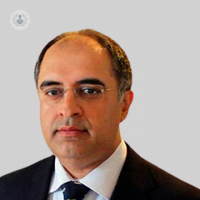What are the benefits of joint replacement surgery?
Written in association with:Joint replacement surgery is a common orthopaedic procedure performed to relieve pain, improve function, and enhance the quality of life of patients who have severe joint damage.
Here, Mr Gurdeep Singh Biring, renowned consultant trauma and orthopaedic surgeon based in Great Missenden and Slough, provides a comprehensive insight into joint replacement surgery.

When is joint replacement recommended?
Joint replacement is a commonly-performed surgical procedure where a damaged joint is replaced with an artificial prosthesis, known as an implant.
Joint replacement surgery may be recommended for:
- Severe joint pain: When pain is unresponsive to conservative pain relief treatments, such as medication, joint injections, or physiotherapy.
- Reduced mobility: When joint stiffness and pain significantly limit movement and daily activities.
- Degenerative joint diseases: In cases of osteoarthritis, rheumatoid arthritis, or other types of arthritis, joint replacement may be recommended.
- Bone loss: In cases of extensive bone loss due to conditions like avascular necrosis.
It is important to discuss your specific symptoms with an orthopaedic surgeon, who will assess your eligibility for joint replacement surgery and help you determine the most appropriate course of treatment.
How is joint replacement surgery performed, and what are the different types of procedures?
Joint replacement surgery is performed under general anaesthesia to ensure the maximum comfort during the procedure. Before the surgery, you will undergo a thorough evaluation, which includes a physical examination, a clinical history review, and several imaging tests (such as x-rays and MRI scans) to assess the joint’s condition.
During the surgery, an incision will first be made over the joint to access the damaged area. In some cases, minimally invasive techniques may be employed to reduce the size of the incision and minimise tissue damage, thereby helping to reduce complications and improve the overall recovery time.
After the incision, the surgeon will either resurface the damaged joint or perform a partial/total joint replacement, depending on the extent of joint damage and the type of procedure recommended.
- Total joint replacement: In a total joint replacement, the entire joint surface is removed and replaced with an implant. This is the most common type of joint replacement, often performed for hip and knee joints.
- Partial joint replacements: In a partial joint replacement, only the damaged cartilage and bone in the joint is removed and replaced with an implant. Healthy tissue in the rest of the joint is left intact.
- Resurfacing: In a resurfacing procedure, the damaged bone and cartilage of the joint is trimmed and reshaped. A metal cap is then fitted in its place. This procedure is commonly used for hip conditions, and is an alternative to total hip replacement in some cases.
Following this, the incision is closed with sutures or staples. You will then be moved to a recovery room to be closely monitored for any signs of complications.
What are the benefits of joint replacement surgery, and what can I expect in terms of pain relief and improved mobility?
Joint replacement is highly effective at relieving joint pain and discomfort, particularly in cases of severe arthritis. Many patients find that they can eliminate the use of pain medications and anti-inflammatories after undergoing joint replacement surgery.
With reduced pain, joint replacement surgery can also help restore joint mobility and improve joint function, increasing range of motion and allowing you to perform daily activities with greater ease. In addition, the new implant will provide stability to the joint, reducing the risk of falls and injuries.
As pain decreases and mobility improves, patients often report a marked improvement in their overall quality of life, as well as their health and fitness. Many patients are able to participate in activities they may have had to avoid due to joint pain, which can help to maintain a healthier lifestyle.
The extent of pain relief and improvement in mobility can vary from patient to patient, so it is important to have realistic expectations and actively participate in post-operative rehabilitation and physical therapy for the best results. Your surgeon will discuss these aspects with you and provide expert guidance on managing the recovery process to optimise your surgical outcome.
How successful is joint replacement surgery, and how long do implants typically last?
Joint replacement surgery is generally considered a highly successful procedure. For hip replacements, success rates are often around 90 per cent to 95 per cent, with most patients experiencing significant pain relief, improved mobility, and enhanced quality of life. For knee replacements, success rates are generally around 85 per cent to 90 per cent, with patients experiencing reduced pain and increased function.
Implants are designed to be durable and last for at least 15 to 20 years. However, this depends on the type of implant used and the patient’s age, activity level, and adherence to post-operative guidelines. Regular follow-up appointments are essential to monitor the condition of the implant and address any issues promptly.
Mr Gurdeep Singh Biring is an award-winning consultant trauma and orthopaedic surgeon with over 25 years of experience.
If you require joint replacement surgery, don’t hesitate to book an appointment with Mr Biring via his Top Doctors profile today to receive expert assessment and treatment.


